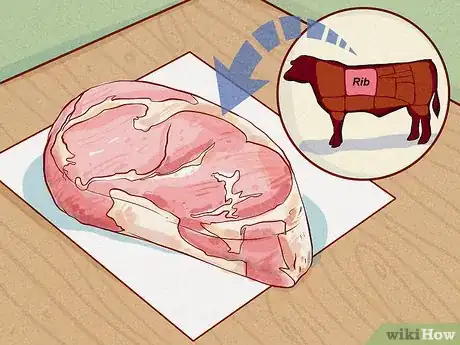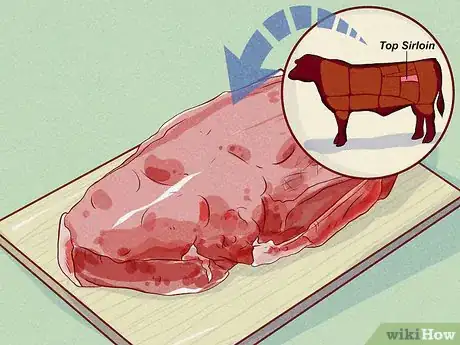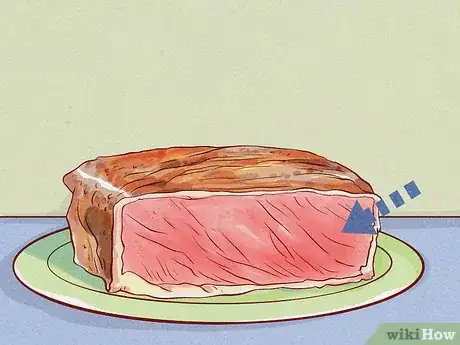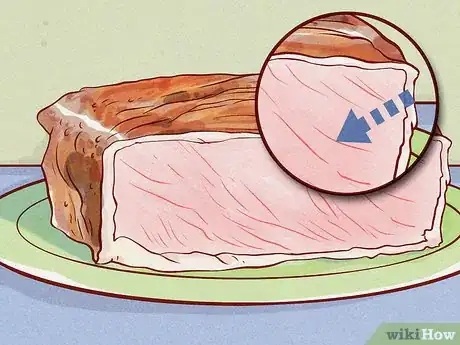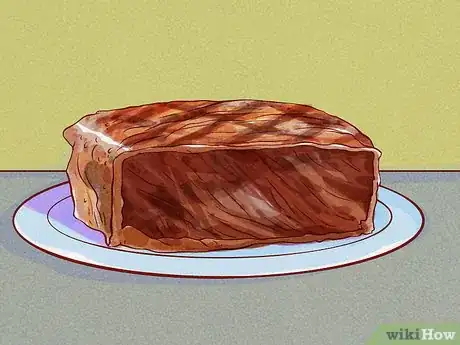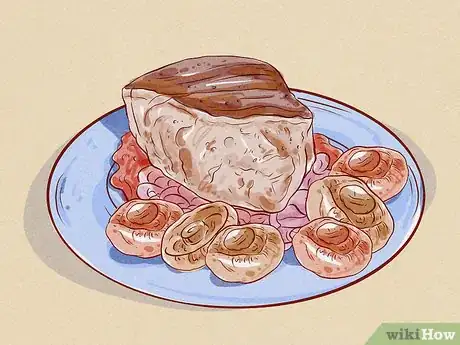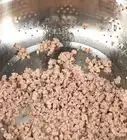This article was co-authored by wikiHow Staff. Our trained team of editors and researchers validate articles for accuracy and comprehensiveness. wikiHow's Content Management Team carefully monitors the work from our editorial staff to ensure that each article is backed by trusted research and meets our high quality standards.
This article has been viewed 46,119 times.
Learn more...
Ordering a meal at a nice steakhouse can be an intimidating experience, especially if you don’t know which cut of meat to choose or how you like it cooked. You can order with confidence by learning about the different cuts of meat, what flavors and textures they’re known for, and what the different cooks will actually look and taste like on a piece of meat. From there, you should be able to make a selection that caters to your preferences.
Steps
Choosing the Right Cut of Meat
-
1Choose a T-bone steak for a tender, flavorful option. This cut comes from the short loin of an animal and is one of the most popular steakhouse cuts. It contains 2 different types of meat: a strip steak on one side and a tenderloin on the other, so it can give you 2 flavors and 2 textures in 1 cut of meat.[1]
- The T-bone is usually a little more expensive than other cuts of meat and can be trickier to cook well because of the different types of meat on it.
-
2Pick a porterhouse for a large, juicy steak with savory flavors. Order this option for a cut that is larger than the T-bone but similar in flavor and texture. The porterhouse also contains both a strip steak and a tenderloin, but it comes from the legs area of an animal.[2]
- The USDA states that the tenderloin portion of the porterhouse steak must be at least 1.25 inches (3.2 cm) at the widest point.[3]
Advertisement -
3Order a rib eye for a piece of meat that is marbled and full of flavor. Don’t be afraid of fat in your steak—the fat is actually what provides the most flavor in any given cut of meat. This cut comes from the rib area of the animal. The rib eye is tender and flavorful and juicy, thanks to the fat content.[4]
- Because of the fat content, this cut of steak gets a little more charred and crispy and smoky when it cooks. While it’s cooking, the dripping fat tends to catch fire or burn faster and creates a very flavorful crust on the steak.
-
4Get a filet mignon for the most tender cut of meat. This is one of the thickest cuts of meat, and it’s popular because of how rich and tender it is. It’s usually the most expensive option on a menu at a steakhouse and is also usually the smallest portion size. The flavor of the filet mignon is mild compared to that of other cuts, so it is often wrapped in bacon or paired with a sauce. Choose this option if you prefer soft, tender meat over robust flavor.[5]
- The filet mignon is also sometimes called a tenderloin, but it is actually cut from a particular section of the tenderloin.
-
5Select a top sirloin for rich flavor without a lot of fat. This cut comes from near the rear of the animal, right underneath where the tenderloin is cut from. It’s a more muscular cut but is also very flavorful. Order the top sirloin if you want a more affordable cut of meat that still retains the meaty flavor of steak.[6]
- Tip: when cutting into a top sirloin, cut against the grain of the meat rather than with it.
-
6Opt for a strip steak for a consistently reliable cut of meat. The strip steak is a tender, thinner cut of meat from the short loin of the animal, from right behind the rib area. It’s not a muscular piece of meat so it is easy to cut. It’s normally a longer piece of meat and can be ordered boneless or bone-in.[7]
- The strip steak is a great option if you like a more well-done cook on your meat. Since it’s thin, it cooks faster and is less likely to burn.
Ordering the Right Cook
-
1Opt for a “blue rare” cook if you like the texture of barely cooked meat. This cut will be brown and warm only on the outside, and the inside will be bright red. The center of a blue rare steak is 50–75 °F (10–24 °C). This option gives you a piece of meat that feels squishier than more well-done cuts.[8]
- This is a less common preferred temperature, and if you are new to eating and ordering steak, try more well-done pieces first before progressing to blue rare.[9]
-
2Ask for a “rare” steak for a slight sear and a mostly red interior. Rare steaks are cooked to about 86–100 °F (30–38 °C) and have a center that is about 75% red. Choose this cook if you don’t mind a slightly bloody cut with juices that will run over the rest of your plate.[10]
- The porterhouse and the rib eye are the cuts that are most often ordered rare.[11]
-
3Order “medium rare” for a thick, brown crust and juicy red center. This is the most common and popular cook and is what is recommended by chefs. The internal temperature for medium rare is 135–145 °F (57–63 °C). Choose this option for a firm, well-browned exterior and an inside that is 50% red.[12]
- Tip: when you cut into a steak to check the doneness, cut straight through the middle. The outsides will always be a little more done, but the interior is where you will see the degree of red that you ordered.
-
4Choose a “medium” cook if you like very little color in your meat. This gives your steak a good char and it will be a rich brown color. The very center of a medium cooked steak will be spongy and slightly red, but the rest of the steak will be firm to the touch.[13]
- About 25% of the steak will be red for a medium cook.
-
5Get your steak cooked “medium well” if you don’t want any color. This steak will be stiff and deeply charred. The risk with getting a medium well cook is that the steak might dry out or get chewy in texture. The very center of the steak may have a small, thin line of pink, but the rest of the meat will be colorless.[14]
- Steaks that hold up with a medium well cook are the ribeye, the T-bone, or any other cut that is highly marbled. The fat content helps keep the meat tender and flavorful.[15]
-
6Pick “well done” for a steak that is fully cooked through. If you’re at a good steakhouse, they should be able to accommodate this order without burning your steak. A well done steak will be highly browned on the outside and will have zero pink in the middle.[16]
- A thinner cut, like the strip steak, is less likely to burn and dry out since it doesn’t take long to cook.
Placing Your Order
-
1Tell the server “No seasonings” to enjoy the flavor of the meat. Good quality meat should be flavorful on its own and won’t need to be brushed with various seasonings before it goes on the grill. You can always add salt and pepper once you get your steak to add a little seasoning if you prefer.[17]
- Remember that the most tender cuts (like the filet mignon) aren’t going to be the most flavorful.
-
2Ask for sauces on the side. If your steak comes with a mushroom and onion topping or a special in-house sauce, ask for it to come on the side. This will let you enjoy the flavor of the steak on its own before adding anything additional to your palate.[18]
-
3Order what you want with confidence. Tell the server what cut of meat you would like, what temperature you would like it cooked to, and any additional requests. If you like a well-done steak, that is okay! Or if you prefer a rare cook, that’s alright, too. Don’t feel pressured into ordering what “experts” say is the best option. At the end of the night, you will enjoy your meal more if it’s made the way you like it.
- If you get your order and your steak isn’t prepared the way you requested, it’s okay to send it back. You’re paying for the meal to be done to your specifications and should get what you ask for.
Community Q&A
-
QuestionHow cooked should I order my steak?
 Drew Hawkins1Community AnswerIt depends on how you like your meat! If you like the taste and texture of lightly cooked meat, you'll want to order it "blue rare." This cut will be brown and warm only on the outside, and the inside will be bright red. The center of a blue rare steak is 50–75 °F (10–24 °C). For a slight sear and a mostly red interior, go with a "rare" steak. If you like a thick, brown crust and a juicy red center, you want to order a "medium rare" steak. It's the most common and popular choice and is actually what most chefs recommend. The internal temperature for medium rare is 135–145 °F (57–63 °C). Choose this option for a firm, well-browned exterior and an inside that is 50% red. If you want very little to no color or blood in your steak, go with a "medium" or a "medium well." And if you want your steak fully cooked all of the way through, then you want to order a "well-done" steak. It'll be highly browned on the outside and will have zero pink in the middle.
Drew Hawkins1Community AnswerIt depends on how you like your meat! If you like the taste and texture of lightly cooked meat, you'll want to order it "blue rare." This cut will be brown and warm only on the outside, and the inside will be bright red. The center of a blue rare steak is 50–75 °F (10–24 °C). For a slight sear and a mostly red interior, go with a "rare" steak. If you like a thick, brown crust and a juicy red center, you want to order a "medium rare" steak. It's the most common and popular choice and is actually what most chefs recommend. The internal temperature for medium rare is 135–145 °F (57–63 °C). Choose this option for a firm, well-browned exterior and an inside that is 50% red. If you want very little to no color or blood in your steak, go with a "medium" or a "medium well." And if you want your steak fully cooked all of the way through, then you want to order a "well-done" steak. It'll be highly browned on the outside and will have zero pink in the middle. -
QuestionWhat's the most tender cut of steak?
 Drew Hawkins1Community AnswerThere are a variety of different cuts of steak and each has a different texture and amount of tenderness. But the most tender of all is the filet mignon. It's one of the thickest cuts of meat, and it’s popular because of how rich and tender it is. It’s also usually the most expensive option on a menu at a steakhouse and is also usually the smallest portion size. The flavor of the filet mignon is mild compared to that of other cuts, so it is often wrapped in bacon or paired with a sauce. If you like soft, tender meat, the filet mignon is the steak for you. If you're looking for a cheaper cut that's still nice and tender, then go with a rib eye steak. This cut comes from the rib area of the animal and is tender, flavorful, and juicy, thanks to the fat content.
Drew Hawkins1Community AnswerThere are a variety of different cuts of steak and each has a different texture and amount of tenderness. But the most tender of all is the filet mignon. It's one of the thickest cuts of meat, and it’s popular because of how rich and tender it is. It’s also usually the most expensive option on a menu at a steakhouse and is also usually the smallest portion size. The flavor of the filet mignon is mild compared to that of other cuts, so it is often wrapped in bacon or paired with a sauce. If you like soft, tender meat, the filet mignon is the steak for you. If you're looking for a cheaper cut that's still nice and tender, then go with a rib eye steak. This cut comes from the rib area of the animal and is tender, flavorful, and juicy, thanks to the fat content. -
QuestionWhat's the rarest you can order a steak?
 Drew Hawkins1Community AnswerThe rarest you can order a steak is called "blue rare." You can also order a steak as "blue" or "extra rare." They all mean the same thing. A "blue rare" steak is cooked until the internal temperature of the center of the cut reaches 50–75 °F (10–24 °C), which helps to make sure any dangerous bacteria or pathogens are cooked out and the steak is safe to eat. Basically, the outside of the steak will be lightly browned and warm while the inside will be a bright red. There will also be a lot of juices when you cut into the steak. If you're new to eating steak, you may want to try a more well-done piece first to see if you like it more on the raw side before you try a "blue rare" steak.
Drew Hawkins1Community AnswerThe rarest you can order a steak is called "blue rare." You can also order a steak as "blue" or "extra rare." They all mean the same thing. A "blue rare" steak is cooked until the internal temperature of the center of the cut reaches 50–75 °F (10–24 °C), which helps to make sure any dangerous bacteria or pathogens are cooked out and the steak is safe to eat. Basically, the outside of the steak will be lightly browned and warm while the inside will be a bright red. There will also be a lot of juices when you cut into the steak. If you're new to eating steak, you may want to try a more well-done piece first to see if you like it more on the raw side before you try a "blue rare" steak.
References
- ↑ https://www.mychicagosteak.com/steak-university/2017/08/15/best-cuts-of-steak/
- ↑ https://www.mychicagosteak.com/steak-university/2017/08/15/best-cuts-of-steak/
- ↑ https://www.mychicagosteak.com/steak-university/2017/08/15/best-cuts-of-steak/
- ↑ https://www.mychicagosteak.com/steak-university/2017/08/15/best-cuts-of-steak/
- ↑ https://www.mychicagosteak.com/steak-university/2017/08/15/best-cuts-of-steak/
- ↑ https://www.mychicagosteak.com/steak-university/2017/08/15/best-cuts-of-steak/
- ↑ https://www.mychicagosteak.com/steak-university/2017/08/15/best-cuts-of-steak/
- ↑ http://www.yoranchsteakhouse.com/dining-at-a-steakhouse-in-dallas-here-are-different-ways-to-order-your-steak/
- ↑ https://fivethirtyeight.com/features/how-americans-order-their-steak/
- ↑ http://www.yoranchsteakhouse.com/dining-at-a-steakhouse-in-dallas-here-are-different-ways-to-order-your-steak/
- ↑ https://fivethirtyeight.com/features/how-americans-order-their-steak/
- ↑ http://www.yoranchsteakhouse.com/dining-at-a-steakhouse-in-dallas-here-are-different-ways-to-order-your-steak/
- ↑ http://www.yoranchsteakhouse.com/dining-at-a-steakhouse-in-dallas-here-are-different-ways-to-order-your-steak/
- ↑ http://www.yoranchsteakhouse.com/dining-at-a-steakhouse-in-dallas-here-are-different-ways-to-order-your-steak/
- ↑ https://fivethirtyeight.com/features/how-americans-order-their-steak/
- ↑ http://www.yoranchsteakhouse.com/dining-at-a-steakhouse-in-dallas-here-are-different-ways-to-order-your-steak/
- ↑ https://www.thehealthyhomeeconomist.com/order-steak-restaurant-get-sick-later/
- ↑ https://www.thehealthyhomeeconomist.com/order-steak-restaurant-get-sick-later/
- ↑ https://www.thehealthyhomeeconomist.com/order-steak-restaurant-get-sick-later/
- ↑ https://firstwefeast.com/features/2016/11/rules-for-ordering-at-a-steakhouse/know-where-good-beef-comes-from
About This Article
If you want to order steak but you're not sure what cut to get, go for a strip steak, because it’s reliably tender and flavorful. Alternatively, choose a filet for the most tender texture, or a rib eye for the richest flavor. Next, tell the server you’d like your steak “medium rare” if you like the meat juicy and slightly red or “medium well” if you prefer the meat cooked almost all the way through. Also, ask for any sauces to be served on the side, so you can enjoy the flavor of the steak before adding anything else to it. For tips on how to politely send a steak back when it isn’t cooked correctly, read on!


